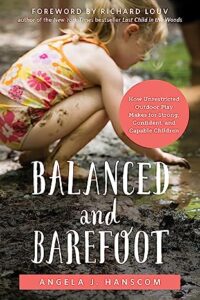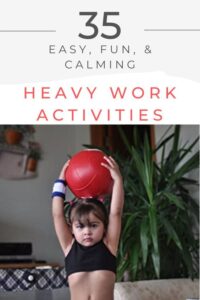
Kick off summer vacation the right way with these 5 strategies to decrease sensory overload this summer for your children, improve their sensory processing skills, and enjoy more family time this summer! This post was created by Marra Robert, OTD, OTRL and contains affiliate links.

Hello Summer! Summertime can be one of the best times of the year. It is full of family time, outdoor play, swimming, vacations, ice cream, and fun, fun, fun! It can also be a big change in family routines for some.
Many kids stay home during the summer months when school is out. My little one is still in daycare during the summer because I work year-round, but we will still have plenty of vacation days and spend weekends at our family cottage. In most families, there is some change in routine once summer is here.
Yes, this is exciting and fun, but changes in routines or a lack of routine can be challenging for our children who haven’t fully developed their sensory systems because of their young age, or they may have some sensory issues, including children with sensory sensitivities. Before we discuss how-to-help-kids-with-sensory-processing-issues we first need to look at sensory processing.
What is Sensory Processing
Sensory processing refers to our ability to take in sensory information through our 8 senses, process and integrate all of the information, and then choose how to respond. If you’d like to learn more, check out What You Need to Know about Sensory Processing

Sensory overload happens when we either receive too much information from our environment or too much of a certain type of sensory input that we do not like and have a more difficult time processing.
Our bodies then feel overwhelmed, impacting our emotional state and sometimes our sense of safety. Sensory overload can activate our flight or fight responses sometimes.
It’s important to understand that sensory overload happens to all of us, children and adults, not just people with sensory processing disorder or autism.
The difference is that children may become more easily overloaded by sensory input and don’t yet have the tools to communicate how they feel and respond. They need help to regulate and return their bodies to a calm state.
So what can we do? There are many strategies we can use to prevent sensory overload for our children.
I have my doctorate in occupational therapy and spent years working with children with sensory processing difficulties and autism and their families. I loved educating families about sensory processing and working with them to find tools and strategies to help decrease sensory overload for their children.
5 TIPS TO REDUCE SENSORY OVERLOAD THIS SUMMER
1. HAVE A SCHEDULE AND TALK TO YOUR KIDS ABOUT IT
Structure and routine are important for children, especially those with sensory processing challenges. However, you want to allow for spontaneity in your routine and teach children how to be flexible. How do you do this? Simply talk to your kids about what’s going on and what’s happening next.
Take a minute and put yourself in your children’s shoes. Imagine having very little control if any, over your schedule, where you go, and who you will see. You, as the parent, make all of those decisions. It’s not that your children want to make those big discussions. That’s too much for them. All they really need to know is what is happening.
This is important for every child. However, it is even more important for children with sensory processing challenges. When a child processes sensory information in their environment, it often impacts their emotions and body feelings.
When they’re not sure what their schedule looks like for the day, where they will go, or what they will do when they might feel overwhelmed and anxious.
It’s pretty simple; all you need to do is talk to your kids about what they will do that day. Focus on what’s happening today, not the vacation they will be on in 2 weeks.
For younger children, focus on what’s happening in the next hour or so, and as they get older, you can go over activities that will happen later in the day or tomorrow. When kids know what to expect, they become more confident and less likely to reach a place of sensory overload.
If possible, try to keep some things consistent such as nap time, bedtime, and meal time as well as creating a summer sensory routine to meet their needs. Summer is a wonderful time for experiencing new activities and going on fun vacations with family.
Most children enjoy exploring new things, and it’s a great opportunity to learn and increase their flexibility. Talking to them about the schedule and what they will be doing next can help them avoid becoming overwhelmed with sensory overload.

Some children respond really well to a visual schedule. A visual schedule has pictures that you can put in order based on the activities your child will do that day. Some of them include brushing teeth, eating, and playing outside.
You can create the schedule in the morning and then return to it throughout the day to see what’s happing next. Kids need structure; even if it is all fun activities, they still like to know what’s happening. Visual schedules are a huge help in preventing sensory overload.
2. DECREASE TOYS AND CLUTTER
Do you ever get overwhelmed by how many toys and clutter are in your home? Well, so does your child. I know as parents, we want to make sure our kids have plenty of toys to play with and activities, but often times less is more, and simple is best.
Toy rotations are a great solution to this. Put half of your child’s toys away and out of sight and then once a month, switch them with the available toys and put those away.
My daughter loves when I rotate her toys each month. She’s so excited to play with the toys she hasn’t seen and usually engages in independent play with them for much longer.
When children have fewer toys to choose from, they can engage in a play activity for a longer period strengthening their attention, and are less likely to reach a state of sensory overload.
Our brains process all the information in our environments, and the more there is in our environment, the more we have to process. When our environments are very busy, our brain has to process more information, which can lead to sensory overload.
Decreasing the toys and clutter in your home can help prevent your child from reaching a place of sensory overload.
If you want to take this one step further, you can create a calming area for your child to go to if they reach a place of sensory overload. This can be a quiet corner in their room, or you can build a fort or tent for them.
The key is that this is a small space with not a lot of toys or clutter in it. It can be a place for pillows, blankets, stuffed animals, and books. No screens, toys that light up or make sounds, just quiet low sensory input items. Your child can come to this space when they feel overwhelmed and need help calming down.
3. PLAY OUTSIDE
My absolute favorite part of summer is spending as much time as possible outside. Being outside is the most calming sensory environment for all of us, especially in nature. It’s because of all the natural elements: air, sounds, smells, textures, and noises. Being outside in nature can be incredibly calming to our nervous systems.
There is growing evidence of how beneficial spending time outside is for child development and how, these days, children are spending significantly less time engaged in outdoor play activities than in previous generations. The pandemic has only made this worse.
If you are curious about all of the benefits of outdoor play, Balanced and Barefoot by Angela Hanscom and Richard Louv is one of my favorite books, and I think it is a must-read for all parents.
Summertime provides so many wonderful play opportunities, so take advantage of it.

4. HEAVY WORK ACTIVITIES
Another amazing way to prevent sensory overload with your children is to incorporate heavy work activities throughout the day. Heavy Work Activities are activities that activate the proprioceptive sensory system.
Proprioception is the sense of joint position and where our body parts are in space. The sensory receptors for this system are in our muscles and joints. This is our sense of body awareness. If you close your eyes, can you touch your nose with your finger? This is because of your proprioception.
Proprioception is a very important sensory system because it is the universal calming sensory system. Activities recommended to help us calm down and relax, such as a massage, a hug, working out, running, punching a pillow, cuddling your kid, and swaddling a baby, all activate the proprioceptive sensory system.
Heavy Work Activities are fun activities that children enjoy that activate the proprioceptive sensory system and help to regulate or calm their bodies. Check out the Top 10 Heavy Work Activities to Regulate Toddlers for some ideas to get you started.

5. TAKE CARE OF YOURSELF
This is one of the most important things you can do to help prevent sensory overload for your children. As parents, we spend so much time worrying about how our children are doing and what they need.
We spend very little time thinking about how we are doing and what we, as individuals, need. The truth is our children can only be as calm as their caregivers. You need to take care of yourself and get to a calm place before you can give your child some calm or create a calm environment for them.
Make sure you are taking care of yourself. I’m a mom, too. I know this is easier said than done. My favorite metaphor for this is a watering can. Your child is a flower, and you are the watering can showering them with everything they need to grow. But you cannot sustain this alone. What happens when you run out of water?
Water cans need a hose to refill. Ask yourself what your hose or lifeline is. Make sure you are taking care of yourself and filling yourself up every week, whatever that looks like. Do it for yourself and your child. I’d love to hear your thoughts and questions. Please leave a comment below.
